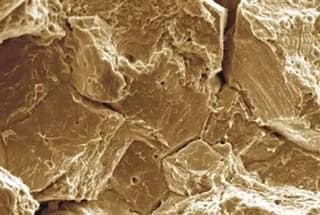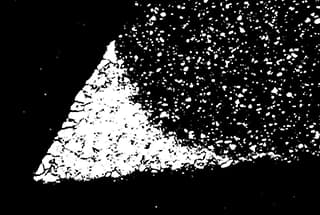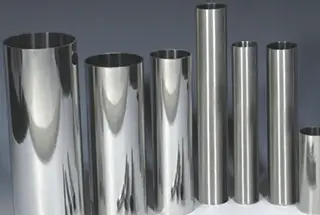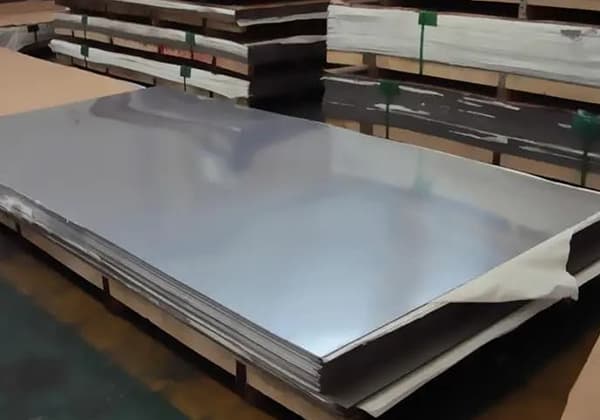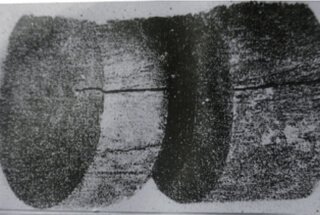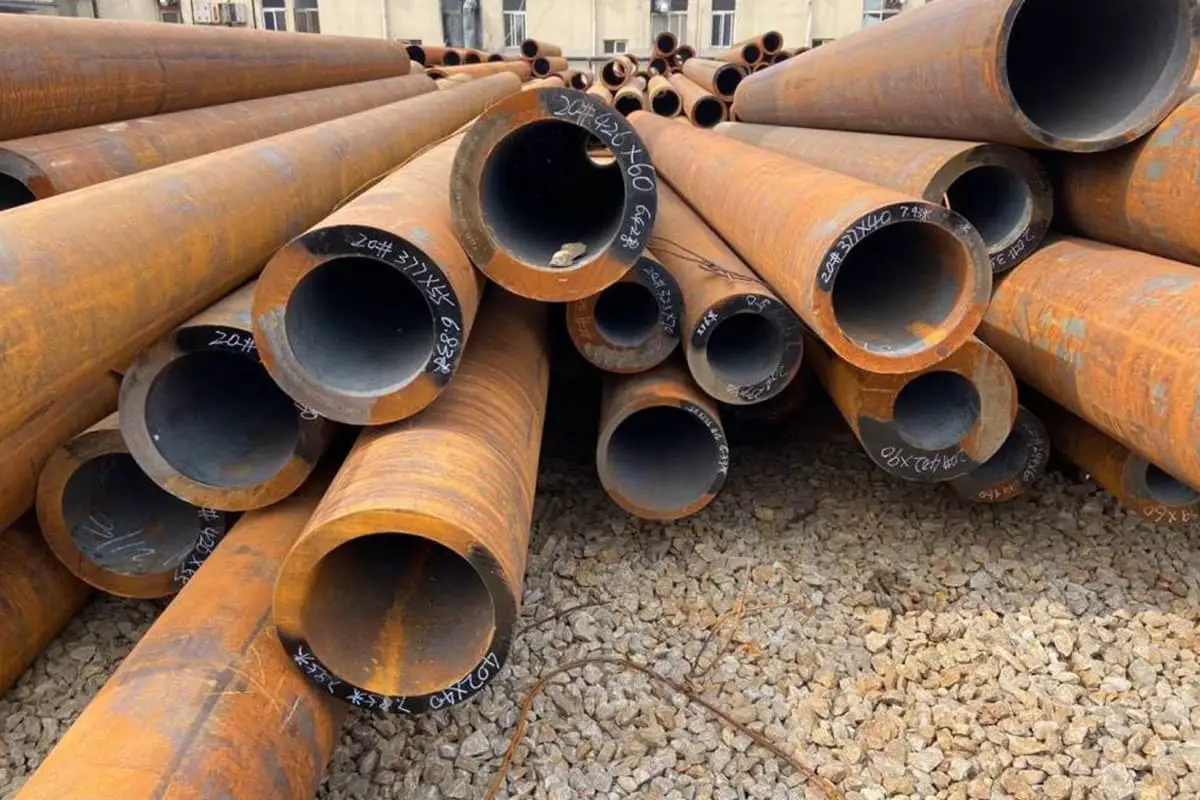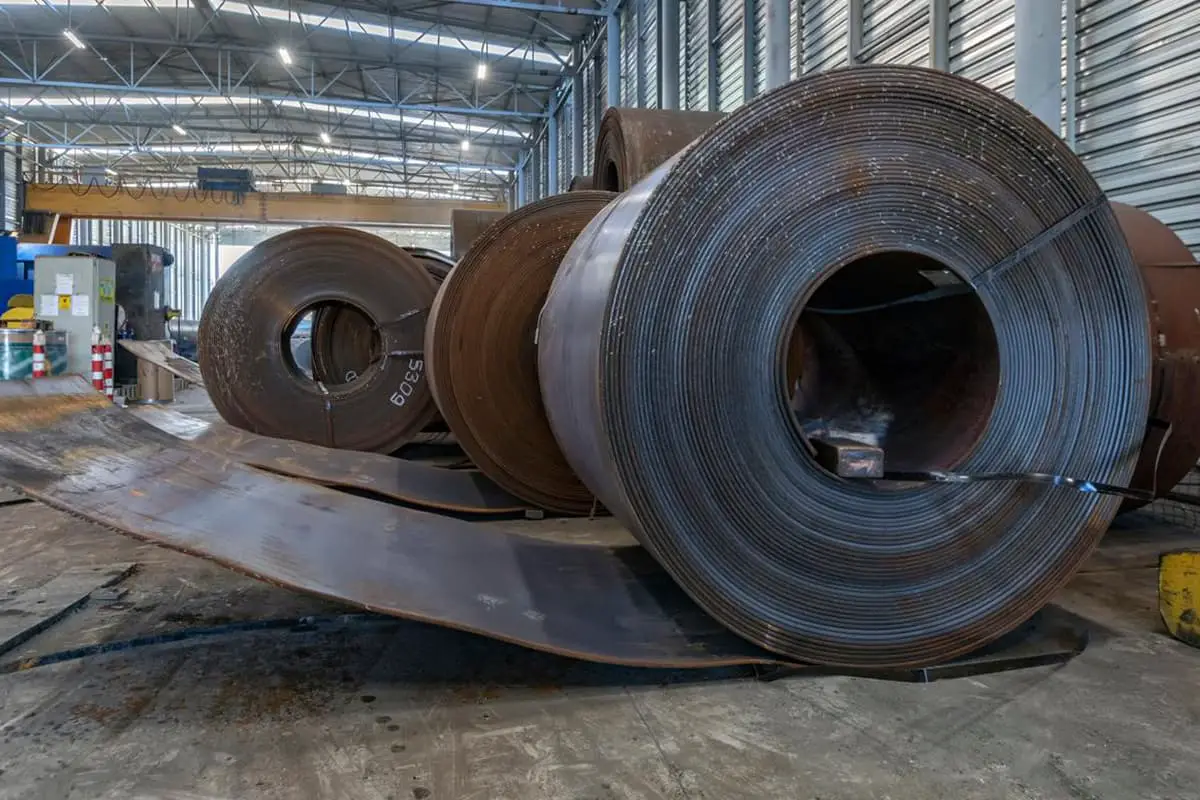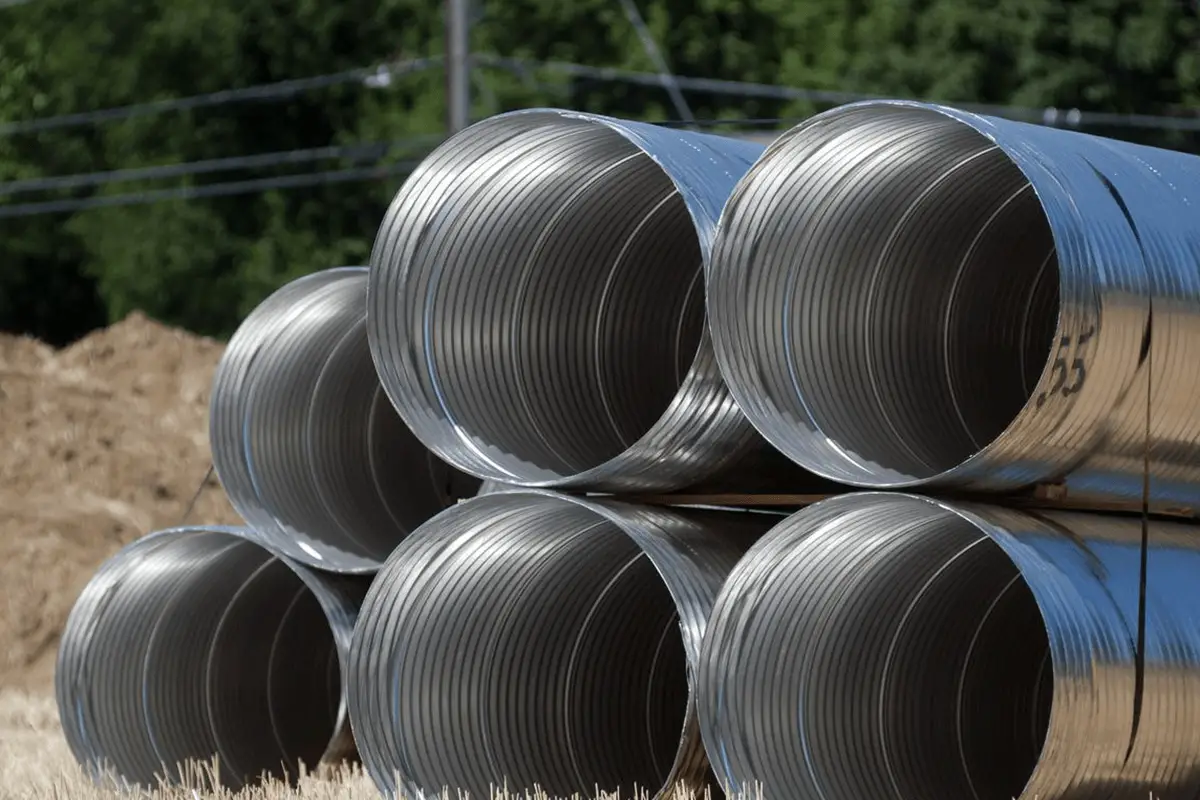Internal Surface Defects
- Internal Fold
Feature: A straight or spiral, semi-spiral sawtooth-shaped defect on the inner surface of the steel pipe.
Causes:
- Pipe blank: center looseness, segregation; serious shrinkage cavity residue; non-metallic inclusions exceed the standard.
- Uneven heating of the pipe blank, too high or too low temperature, and too long heating time.
- Perforation area: severe top wear; improper adjustment of perforation machine parameters; aging of perforation rolls, and so on.
Inspection: Internal folds are not allowed on the inner surface of the steel pipe. The inner fold at the end of the pipe should be repaired by grinding or cutting again. The actual wall thickness value of the grinding position should not be less than the minimum value required by the standard. The entire length of the internal fold should be rejected.
- Internal Scar
Feature: The inner surface of the steel pipe shows spots and scars, which generally do not root and are easy to peel off.
Causes:
- Impurities in the graphite lubricant.
- The iron ear at the back end of the rough pipe is pressed into the inner wall of the steel pipe.
Inspection: Internal scars are not allowed on the inner surface of the steel pipe. The end of the pipe should be ground and cut again. The depth of the grinding should not exceed the negative deviation of the standard requirements, and the actual wall thickness should not be less than the minimum value required by the standard. The entire length of the internal scar should be rejected.
- Curling Skin
Feature: Small skin with straight or intermittent nail-like curls on the inner surface of the steel pipe. It often appears at the head of the capillary and is easy to peel off.
Causes:
- Improper adjustment of perforation machine parameters.
- Sticky steel at the top.
- Accumulation of oxidized iron skin in the rough pipe.
Inspection: Curling skin that is easy to peel off (or can be burned off during heat treatment) is allowed on the inner surface of the steel pipe. For rooted curling skin, it should be ground or removed.
- Internal Straight Scratch
Feature: A straight scratch with a certain width and depth on the inner surface of the steel pipe.
Causes:
- Rolling temperature is low, and the core bar is sticky with metal hard objects.
- Impurities in the graphite, etc.
Inspection:
- The maximum depth of the internal straight scratch allowed for casing and ordinary pipes is 5% (the maximum depth for pressure vessels is 0.4mm).
Careful examination is required for Chad’s internal straight scratches, which should be ground or removed.
The sharp-edged internal straight scratches should be smoothed by grinding.
- Internal Ridge
Feature: A straight protrusion with a certain width and depth on the inner surface of the steel pipe.
Causes: Severe core bar wear, irregular or too deep grinding.
Inspection:
- For casing and pipeline pipes, the maximum height of the internal ridge allowed is 8% of the wall thickness, and the maximum height is 0.8mm without affecting the diameter. The deviation should be repaired by grinding and cutting again.
- For ordinary pipes and pipeline pipes, the maximum height of the internal ridge allowed is 8% of the wall thickness, and the maximum height is 0.8mm. The deviation should be repaired by grinding and cutting again.
- For steel pipes required to meet L2 level (N5) flaw detection requirements, the maximum height of the internal ridge should not exceed 5% (the maximum height is 0.5mm). The deviation should be repaired by grinding and cutting again.
- The sharp-edged internal ridges should be smoothed by grinding.
- Internal Bulge
Feature: Regular convex protrusions on the inner surface of the steel pipe without damage to the outer surface.
Causes: Excessive grinding or loss of meat of the continuous rolling rolls.
Inspection: Inspect according to the requirements for internal ridges.
- Pull Concave
Feature: Regular or irregular pits on the inner surface of the steel pipe without damage to the outer surface.
Causes:
- Improper adjustment of continuous rolling, and the rolling speeds of each frame roller do not match.
- Uneven heating of the pipe blank or too low temperature.
- Deviation of the rolling centerline, collision between the steel pipe and the continuous rolling back road, etc. (Note: This reason was proposed in January 2003, and the principle is still being explored.)
Inspection: Pull concaves with a negative deviation not exceeding the wall thickness and an actual wall thickness greater than the minimum wall thickness required are allowed to exist. Excessive pull concaves should be cut off. (Note: Serious development of pull concaves can lead to tearing, which should be strictly inspected.)
- Internal Thread (This defect only occurs in Assel units)
Feature: Spiral traces on the inner surface of the steel pipe, which mostly appear on the inner surface of thin-walled pipes and have an obvious uneven feel.
Causes:
- Inherent defects in the skew rolling process. This defect is more prominent when the process parameters of the Assel pipe mill are improperly adjusted.
- The distribution of deformation is unreasonable, and the wall thickness reduction of the Assel pipe mill is too large.
- Improper configuration of the Assel rolling groove.
Inspection: The depth of the internal thread defect on the steel pipe should not exceed 0.3mm and should be within a certain tolerance range.
External Surface Defects
- External Folding
Features: Spiral-shaped layer folding on the outer surface of the steel pipe.
Causes:
- Folding or cracking on the surface of the pipe blank.
- Subcutaneous pores or severe subcutaneous inclusions in the pipe blank.
- Poor cleaning on the surface of the pipe blank, or ear, wrong face, etc.
- Scratches on the surface of the steel pipe caused by lifting during rolling, which are then pressed onto the matrix of the steel pipe to form external folding.
Inspection: Not allowed to exist. Slight folding can be ground, and after grinding, the actual wall thickness and outer diameter value shall not be less than the minimum value required by the standard.
- Delamination
Features: Spiral or block-shaped layering and cracking on the surface of the steel pipe.
Causes: Serious non-metallic inclusions, residual shrinkage holes, or severe looseness in the pipe blank.
Inspection: Not allowed to exist.
- External Scarring
Features: Spots or scars on the outer surface of the steel pipe.
Causes:
- Roll sticking, aging, severe wear, or scratch marks.
- Foreign objects or severe wear on the conveying rollers.
Inspection:
- The scarring area should be ground or removed in pieces.
- For pipe sections with scarring, scarring area exceeding 10% should be cut off or ground.
- Scarring deeper than 5% of the wall thickness should be ground.
- The actual wall thickness and outer diameter value at the grinding location shall not be less than the minimum value required by the standard.
- Rough Surface
Features: Uneven pits on the surface of the steel pipe.
Causes:
- The steel pipe stays in the furnace for too long or is heated for too long, resulting in the formation of thick oxide scale on the surface, which is not cleaned properly and rolled into the surface of the steel pipe.
- Malfunction of the high-pressure water phosphorus removal equipment, resulting in incomplete phosphorus removal.
Inspection:
- Local rough surfaces not exceeding the negative wall thickness deviation are allowed.
- The rough surface area shall not exceed 20% of the area of the pipe section with rough surfaces.
- Rough surfaces exceeding the standard can be ground or cut off, and the actual wall thickness and outer diameter value at the grinding location shall not be less than the minimum value required by the standard.
- Serious rough surfaces are judged as waste.
- Green Line
Features: Symmetric or asymmetric straight rolling marks on the outer surface of the steel pipe.
Causes:
- Misalignment or severe wear of the diameter sizing machine hole shape.
- Unreasonable design of diameter sizing machine roller hole shape.
- Cold rolling of steel.
- Poor machining of the rolling mill, with small chamfers at the edges of the rollers.
- Poor assembly of the rollers, with excessive gaps, etc.
Inspection:
- A green line with a height not exceeding 0.2mm is allowed on the outer surface of the casing, and exceeding the standard should be ground.
- Hand-feeling green lines are not allowed in high-pressure container pipes. Hand-feeling green lines must be removed. The grinding location should be smooth without sharp corners.
- General pipes (structural, fluid, hydraulic support, etc.) allow a green line with a height not exceeding 0.4mm to exist, and exceeding the standard should be ground.
- Sharp green lines at the edges should be ground smooth.
- The actual values of the wall thickness and outer diameter at the grinding location shall not exceed the minimum value required by the standard.
- Hairline Crack
Features: Continuous or discontinuous hairline cracks on the outer surface of the steel pipe.
Causes:
- Subcutaneous pores or inclusions in the pipe blank.
- Incomplete cleaning of the surface of the pipe blank, with small cracks present.
- Over-worn or aged rollers.
- Poor machining accuracy of the rollers, etc.
Inspection: Visible hairline cracks on the outer surface of the steel pipe are not allowed. If they exist, they must be completely removed, and the actual values of the wall thickness and outer diameter after removal must not be less than the minimum value required by the standard.
- Net-like Crack
Features: Striped and helical fish-scale-like small cracks on the outer surface of the steel pipe.
Causes:
- High content of harmful elements (such as arsenic) in the pipe blank.
- Aging and sticking of perforation rollers.
- Sticking of guide plates, etc.
Inspection: They must be completely removed. After removal, the actual values of the wall thickness and outer diameter must not be less than the minimum value required by the standard.
- Scratch
Features: Spiral or straight groove-shaped defects on the outer surface of the steel pipe, with the bottom of the groove mostly visible.
Causes:
- Mechanical scratches mainly occur in roller paths, cold beds, straightening, and transportation.
- Poor machining or severe wear of the rolling mill, or foreign objects in the roll seam, etc.
Inspection:
- Local scratches not exceeding 0.5mm are allowed on the outer surface of the steel pipe, and scratches exceeding 0.5mm should be ground. The actual values of the wall thickness and outer diameter at the grinding location must not be less than the minimum value required by the standard.
- Sharp scratches at the edges should be ground smooth.
- Dent
Features: The outer surface of the steel pipe presents a concave-convex phenomenon, while the wall thickness of the steel pipe remains undamaged.
Causes:
- Dents caused by impact during lifting.
- Dents caused by biting during straightening.
- Dents caused by the diameter sizing machine back roller path, etc.
Inspection: Local dents that do not exceed the negative deviation of the outer diameter and have a smooth surface can exist. When exceeding the standard, they should be cut off.
- Impact Damage
Features: Irregular scars on the outer surface of the steel pipe due to collision.
Causes: Can occur due to various collisions in the cold and hot areas.
Inspection:
- Local impact damage with a depth not exceeding 0.4mm is allowed on the outer surface.
- Impact damage exceeding 0.4mm should be ground smooth, and the actual values of the outer diameter and wall thickness at the grinding location must not be less than the minimum value required by the standard.
- Straightening Depression
Features: A spiral depression on the outer surface of the steel pipe.
Causes:
- Improper adjustment of the straightening machine roller angle and excessive pressing force.
- Severe wear of the straightening roller, etc.
Inspection: The outer surface of the steel pipe can have straightening depressions without obvious sharp corners and without protrusions on the inner surface, and the outer diameter size should meet the tolerance requirements. Exceeding the standard straightening depressions should be cut off.
- Fold
Features: Local or longitudinal wrinkles along the wall of the steel pipe with a concave-convex appearance, and the outer surface presents a strip-like depression.
Causes:
- The selection of the hole expansion coefficient is too small.
- Improper adjustment of the rolling mill leads to hole deviation or inconsistent rolling centerline.
- Improper distribution of the pressing force on each frame of the continuous rolling mill.
Due to the above reasons, metal enters the gap between the rollers during rolling, or the tube loses stability, resulting in wrinkles on the tube wall.
Inspection: Not allowed. Should be cut off or scrapped.
- Tearing
Features: The surface of the steel pipe has a phenomenon of being pulled apart and broken, mostly on thin-walled pipes.
Causes:
- Due to uneven heating of the tube blank, the deformation part is tight, and the low-temperature part is subjected to tensile rolling. When the tensile force is large, the tube is torn.
- Improper adjustment of the speed and roll seam of each frame of the continuous rolling mill causes the steel to be pulled and torn.
- The wall thickness of the mother pipe supplied by the perforating machine to the continuous rolling mill is small, and the metal deformation on the continuous rolling mill is smaller than the designed deformation, resulting in tensile rolling and tearing when the tensile force is large.
- The tube blank itself has severe inclusions in some areas.
Inspection: Not allowed. Should be cut off or scrapped.
The Size Is Way Off
1. Uneven wall thickness
Features: The wall thickness of the steel pipe is uneven on the same cross-section, with a large difference between the maximum and minimum wall thickness.
Causes:
- Uneven heating of the billet.
- Misalignment of the piercing machine rolling line and unstable centering rolls.
- Worn out or eccentric top heads.
- Correction of the billet centering hole.
- Excessive curvature or skewness of the billet.
Inspection: Measure each pipe individually and cut off the uneven ends of the wall thickness.
2. Deviation in wall thickness
Features: The wall thickness of the steel pipe deviates in one direction, with positive deviation referred to as over thickness, and negative deviation referred to as under thickness.
Causes:
- Uneven heating of the billet.
- Improper adjustment of the piercing machine.
Inspection: Measure each pipe individually and cut off the ends with deviations, or re-inspect the entire length and change the judgment or discard the pipe.
3. Deviation in outer diameter
Features: The outer diameter of the steel pipe is out of specification, with positive deviation referred to as oversize, and negative deviation referred to as undersize.
Causes:
- Excessive wear of the hole type of the sizing machine, or improper design of new hole types.
- Unstable final rolling temperature.
Inspection: Measure each pipe individually and change the judgment or discard the pipe if it is out of specification.
4. Bending
Features: A bend in the steel pipe that is not straight along the length or appears as a goose head shape at the end is called a “goose neck bend”.
Causes:
- Caused by localized water cooling during manual heat inspection.
- Improper adjustment during straightening, with severe wear of the straightening rolls.
- Improper machining, assembly, and adjustment of the sizing machine.
- Bending caused during lifting and transportation.
Inspection: For excessive bending, secondary straightening can be performed, otherwise the pipe is discarded. “Goose neck bends” that cannot be straightened should be cut off.
5. Deviation in length
Features: The length of the steel pipe exceeds the requirement, with positive deviation referred to as long length, and negative deviation referred to as short length.
Causes:
- Billet length exceeds standard.
- Unstable rolling.
- Improper control during cutting.
Inspection: Cut long length pipes again or change the judgment, and change the judgment or discard short length pipes.
